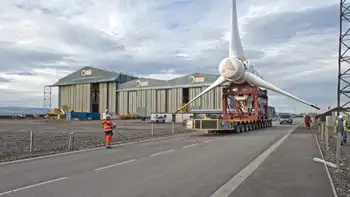Energy production endangering birds
By Associated Press
Arc Flash Training CSA Z462 - Electrical Safety Essentials
Our customized live online or in‑person group training can be delivered to your staff at your location.

- Live Online
- 6 hours Instructor-led
- Group Training Available
The first-of-its-kind government report chronicles a four-decade decline in many of the country's bird populations and provides many reasons for it, from suburban sprawl to the spread of exotic species to global warming.
In almost every case, energy production is also playing a role.
"Energy development has significant negative effects on birds in North America," the report concludes.
Birds can collide with wind turbines and oil and gas wells, and studies have shown that some species, such as Prairie-chickens and sage grouse, will avoid nesting near the structures.
Ponds created during the extraction of coalbed methane gas breed mosquitoes that carry West Nile virus, leading to more bird deaths. Transmission lines, roads to access energy fields and mountaintop removal to harvest coal can destroy and fragment birds' living spaces.
Environmentalists and scientists say the report should signal to the Obama administration to act cautiously as it seeks to expand renewable energy production and the electricity grid on public lands and tries to harness wind energy along the nation's coastlines.
The report also shows that conservation efforts can work. Birds that reside in wetlands and the nation's waterfowl have rebounded over the past 40 years, a period marked by increased protections for wetlands.
"We need to go into these energies with our environmental eyes open," said John Fitzpatrick, the director of the Cornell Lab of Ornithology, which helped draft the report along with non-profit advocacy groups. "We need to attend to any form of energy development, not just oil and gas.''
Many of the bird groups with the most rapid declines in the last 40 years inhabit areas with the greatest potential for energy development.
Among the energy-bird conflicts cited by the report:
More than half of the monitored bird species that live on prairies have experienced population losses. These birds, such as the Lesser Prairie Chicken, are threatened by farmers converting grasslands into cornfields to meet demand for biofuels.
In the Arctic, where two-thirds of all shorebirds are species of concern, melting ice brought about by climate change could open up more areas to oil and gas production. Studies show that trash near drilling rigs attracts gulls that prey on other species.
Mountaintop coal mining in Appalachia clears patches of forest contributing to the decline of birds like the Cerulean warbler that breeds and forests in treetops.
The U.S. State of Birds report, released by the Interior Secretary Ken Salazar, was requested in October 2007 by President George W. Bush.
Salazar, who wants to establish renewable energy zones and is drawing up rules for offshore wind energy production, said the report should "be a call to action, but it is action in our reach.''
The report uses data from three long-running bird censuses to establish trends over time. It shows that birds in Hawaii are more in danger of becoming extinct than anywhere else in the United States. In the last 40 years, populations of birds living on prairies, deserts and at sea have declined between 30 and 40 per cent.
While its findings are similar to earlier studies, it is the first to be issued by the government and the agency in charge of managing energy production on public lands and protecting the nation's wildlife.
The report did not indicate whether one form of energy production is more detrimental than the other.











